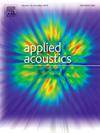Research on SONAH calculation accuracy optimization based on sparse matrix
IF 3.4
2区 物理与天体物理
Q1 ACOUSTICS
引用次数: 0
Abstract
This study proposes an enhanced Statistically Optimized Near-field Acoustic Holography that integrates sparse matrix technique to address the longstanding challenge of low-frequency reconstruction accuracy. Conventional SONAH, while efficient and widely used, suffers from high condition numbers and numerical instability at low frequencies due to the smooth variation of sound pressure and dense propagation matrices. By leveraging the inherent sparsity in the propagation and reconstruction matrices, the proposed approach significantly improves numerical stability. The method is validated through both numerical simulations and field experiments conducted in a fully anechoic chamber using a scanning microphone array. Simulation results show that the sparse matrix-based algorithm achieves a notable reduction in average reconstruction error within the 100–500 Hz octave bands, outperforming the conventional SONAH by an average of 3.3 dB. Furthermore, field experiment results confirm the superior performance of the proposed algorithm, with an overall average reconstruction error that is 7.3 dB lower than that of the traditional approach. In addition to its accuracy advantages, the sparse matrix-based algorithm also demonstrates improved computational efficiency, utilizing approximately 20 % of the CPU resources, in contrast to the 60 % consumed by the conventional SONAH. This represents a reduction of two-thirds in CPU usage, highlighting the improved computational efficiency of the proposed approach. Given its compatibility with a wide range of measurement configurations and its enhanced performance in low-frequency reconstruction, the proposed method shows promise for practical applications such as mechanical fault diagnosis and architectural acoustic analysis. Further validation using high-channel-count and irregular array configurations is expected to extend its applicability to more complex field scenarios. Overall, this work highlights the potential of sparse matrix integration to enhance SONAH and offers new insights for effective sound field reconstruction in complex acoustic environments.
基于稀疏矩阵的SONAH计算精度优化研究
本研究提出了一种增强的统计优化近场声学全息技术,该技术集成了稀疏矩阵技术,以解决低频重建精度的长期挑战。传统SONAH虽然效率高,应用广泛,但由于声压的平滑变化和密集传播矩阵,在低频处存在条件数高和数值不稳定的问题。利用传播矩阵和重构矩阵固有的稀疏性,该方法显著提高了数值稳定性。通过数值模拟和全消声室的现场实验验证了该方法的有效性。仿真结果表明,基于稀疏矩阵的算法在100 ~ 500 Hz频带内的平均重构误差显著降低,比传统的SONAH算法平均降低3.3 dB。此外,现场实验结果证实了该算法的优越性能,总体平均重构误差比传统方法低7.3 dB。除了精度优势外,基于稀疏矩阵的算法还显示出更高的计算效率,与传统的SONAH消耗的60%的CPU资源相比,它利用了大约20%的CPU资源。这表示CPU使用量减少了三分之二,突出了所提出方法的计算效率的提高。由于该方法具有广泛的测量配置兼容性,并且在低频重构中具有更好的性能,因此该方法在机械故障诊断和建筑声学分析等实际应用中具有广阔的前景。使用高通道计数和不规则阵列配置的进一步验证有望将其适用性扩展到更复杂的现场场景。总的来说,这项工作强调了稀疏矩阵集成增强SONAH的潜力,并为复杂声环境中有效的声场重建提供了新的见解。
本文章由计算机程序翻译,如有差异,请以英文原文为准。
求助全文
约1分钟内获得全文
求助全文
来源期刊

Applied Acoustics
物理-声学
CiteScore
7.40
自引率
11.80%
发文量
618
审稿时长
7.5 months
期刊介绍:
Since its launch in 1968, Applied Acoustics has been publishing high quality research papers providing state-of-the-art coverage of research findings for engineers and scientists involved in applications of acoustics in the widest sense.
Applied Acoustics looks not only at recent developments in the understanding of acoustics but also at ways of exploiting that understanding. The Journal aims to encourage the exchange of practical experience through publication and in so doing creates a fund of technological information that can be used for solving related problems. The presentation of information in graphical or tabular form is especially encouraged. If a report of a mathematical development is a necessary part of a paper it is important to ensure that it is there only as an integral part of a practical solution to a problem and is supported by data. Applied Acoustics encourages the exchange of practical experience in the following ways: • Complete Papers • Short Technical Notes • Review Articles; and thereby provides a wealth of technological information that can be used to solve related problems.
Manuscripts that address all fields of applications of acoustics ranging from medicine and NDT to the environment and buildings are welcome.
 求助内容:
求助内容: 应助结果提醒方式:
应助结果提醒方式:


